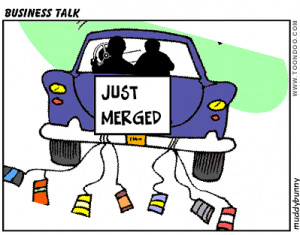Over the past 2 years, the world has seen many behemoth enterprises amalgamate into organizations of astronomical size. Just recently, German chemical manufacturer pu rchased American seed maker Mosanto for 66 billion in cash; the largest cash deal ever. Despite the gargantuan sum of the transaction, these kind of takeovers are becoming a norm in the global scene of business; over the past 2 years Heinz has taken over Kraft, Anheuser Busch purchased SAP Miller and so on. This paradigm shift raises a serious question: what sort of implications do these mergers and acquisitions have on the business environment?
rchased American seed maker Mosanto for 66 billion in cash; the largest cash deal ever. Despite the gargantuan sum of the transaction, these kind of takeovers are becoming a norm in the global scene of business; over the past 2 years Heinz has taken over Kraft, Anheuser Busch purchased SAP Miller and so on. This paradigm shift raises a serious question: what sort of implications do these mergers and acquisitions have on the business environment?
Mergers and Acquisitions – if executed properly – can create a vast amount of wealth for shareholders, substantially increase profits and help businesses adopt a new competitive advantage; mergers can create synergy in a business. Why do companies merge? Often for a variety of reasons: to diversify and increase productive capacity; to fend of international competition, and to increase supply chain purchasing power etc. To determine the viability of merger, executives see if the strengths and weaknesses are similar amongst the businesses, so that a merger would strengthen them in a complementary way. For example, any business with high fixed costs benefits from what is called an economy of scale, wherein by merging with another entity, the business can reduce average costs and thus is able to offer consumers a more competitive price. Overall, mergers propel companies to a more efficient and integrated business model.
Ultimately, however, there are significant economic drawbacks and risks that evolve inexorably from mergers; prices become higher, consumers have less choice and workers lose their job due to budget cuts. When firms merge, competition in that particular industry decreases which creates a monopolistic industry with high barriers to entry: less firms will be willing to enter. As a result of high entry barriers, supply chains become concentrated, Also, as seen within the 2008 crisis, firms grow to a level of being ‘too big to fail’, wherein there demise would reek catastrophic damage to the global economy.
As Megan Ruesink puts it: “Without mergers and acquisitions, many of the most well-known brands and companies would not be where they are today.” I do ultimately agree, but at current pace of mergers between large companies, caution should be taken. In my opinion, governments should adopt tighter regulations regarding mergers; in contrast to the benefits given to shareholders, innovation and entrepreneurialism suffer. In a culture where behemoth corporations dominate, entrepreneurs no longer aspire to build empires, rather they dream of selling their company to a multinational and cashing out. Entrepreneurialism is what built the greatest companies in the world; we shouldn’t lose that art.
Words: 447
Sources
Blog Cited: Megan Ruesink: http://www.rasmussen.edu/degrees/business/blog/best-and-worst-corporate-mergers/
http://www.sauder.ubc.ca/News/2016/Q_and_A_Inside_the_Bayer-Monsanto_mega-merger
Picture: http://english-magazine.org/fun-and-leisure/english-cartoons/1473-teacher-cartoon626